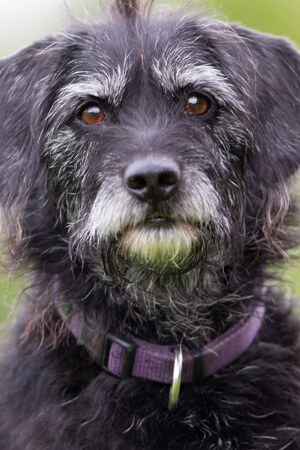 It’s no secret that stressful life events can exert any number of changes on the human body. Most noticeable among these is premature graying of scalp hair—as even a cursory examination of “before-term” and “after-term” photos of past U.S. presidents will attest. Now, a new study authored by NIU alumnus Camille King and NIU professor Thomas Smith, appearing in Applied Animal Behaviour Science, has found that young dogs, too, are susceptible to stress-induced graying.
It’s no secret that stressful life events can exert any number of changes on the human body. Most noticeable among these is premature graying of scalp hair—as even a cursory examination of “before-term” and “after-term” photos of past U.S. presidents will attest. Now, a new study authored by NIU alumnus Camille King and NIU professor Thomas Smith, appearing in Applied Animal Behaviour Science, has found that young dogs, too, are susceptible to stress-induced graying.
King and Smith, together with animal behaviorist Peter Borchelt and renowned author/researcher Temple Grandin visited dog parks, dog shows, veterinary clinics, and other venues across the front range of Colorado, examining 400 dogs and administering dog behavior questionnaires to their owners. Additionally, independent raters rated the extent of muzzle grayness based on photos of the dogs taken on-site. Results showed that dogs between 1- 4 years of age exhibiting higher owner-reported signs of anxiety showed a greater extent of premature muzzle graying than their less anxious dog peers. Increased muzzle grayness also was related to owner-reported symptoms of impulsivity in the dogs. Additionally, female dogs showed higher levels of grayness than male dogs, but dog size, spay/neuter status and the presence of medical problems did not significantly predict the extent of muzzle grayness.
“Based on my years of experience observing and working with dogs, I’ve long had a suspicion that dogs with higher levels of anxiety and impulsiveness also show increased muzzle grayness,” said King, who earned her doctorate in NIU’s Adult and Higher Education program in 2011, and now has her own animal behavior practice in the Denver, CO, area.
Smith, who provided methodological and statistical expertise, noted that “At first, I was somewhat skeptical of the hypothesis. However, when we analyzed the data, the results actually were quite striking.”
Grandin, professor of Animal Science at Colorado State University, added, “This is an original, unique study that has implications for dog welfare.”
This is the second article examining dog anxiety that King, Smith and Grandin have published. In 2014, the team (together with dog behavior consultant, Laurie Buffington) published research in the Journal of Veterinary Behavior examining the effect of pressure wraps (e.g., “Thundershirts”) on heart rate levels and symptoms of anxiety in dogs. This study found that the use of such pressure wraps can markedly decrease heart rate in anxious dogs and also affect other behavioral measures of stress.
